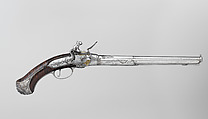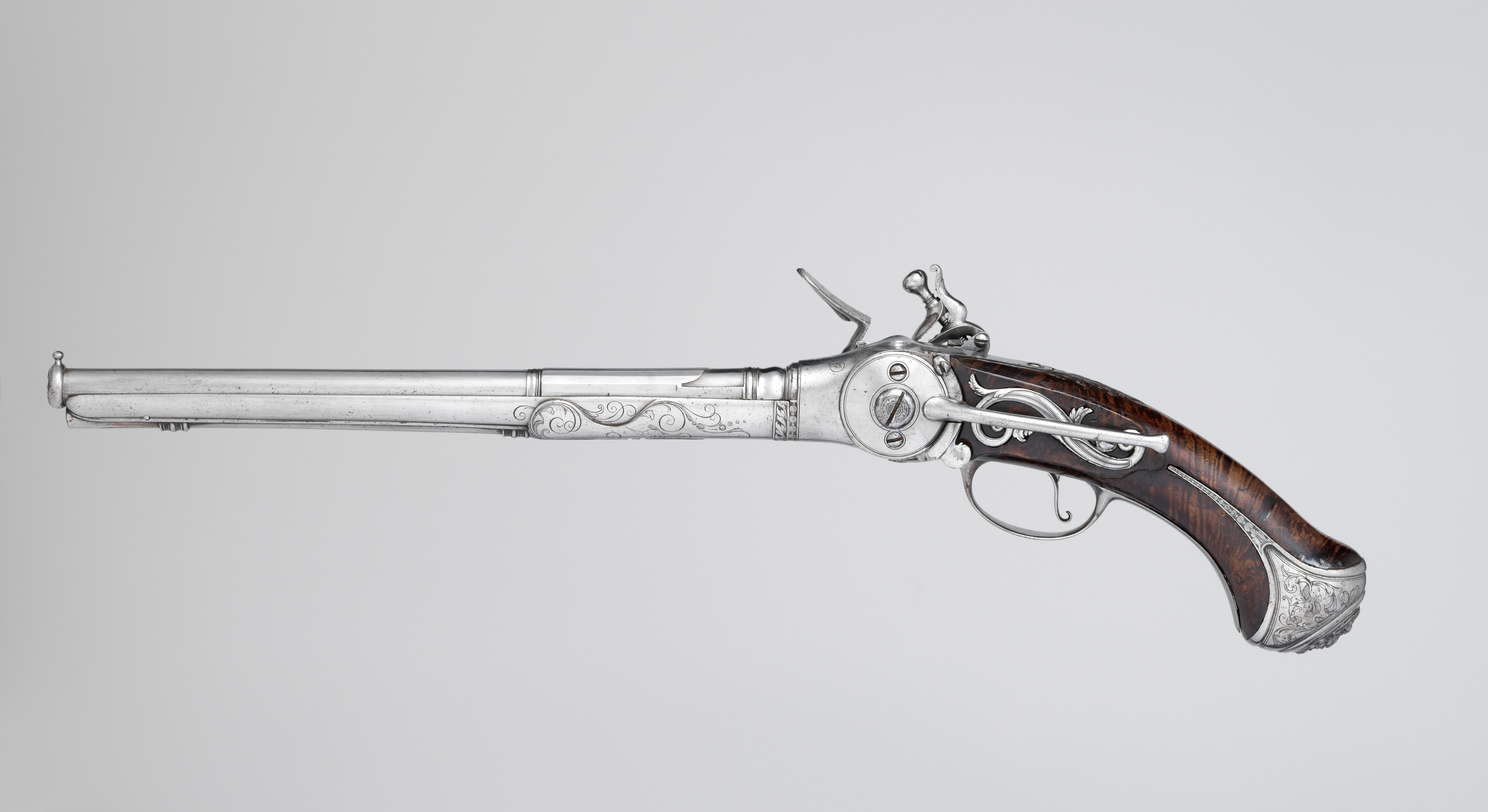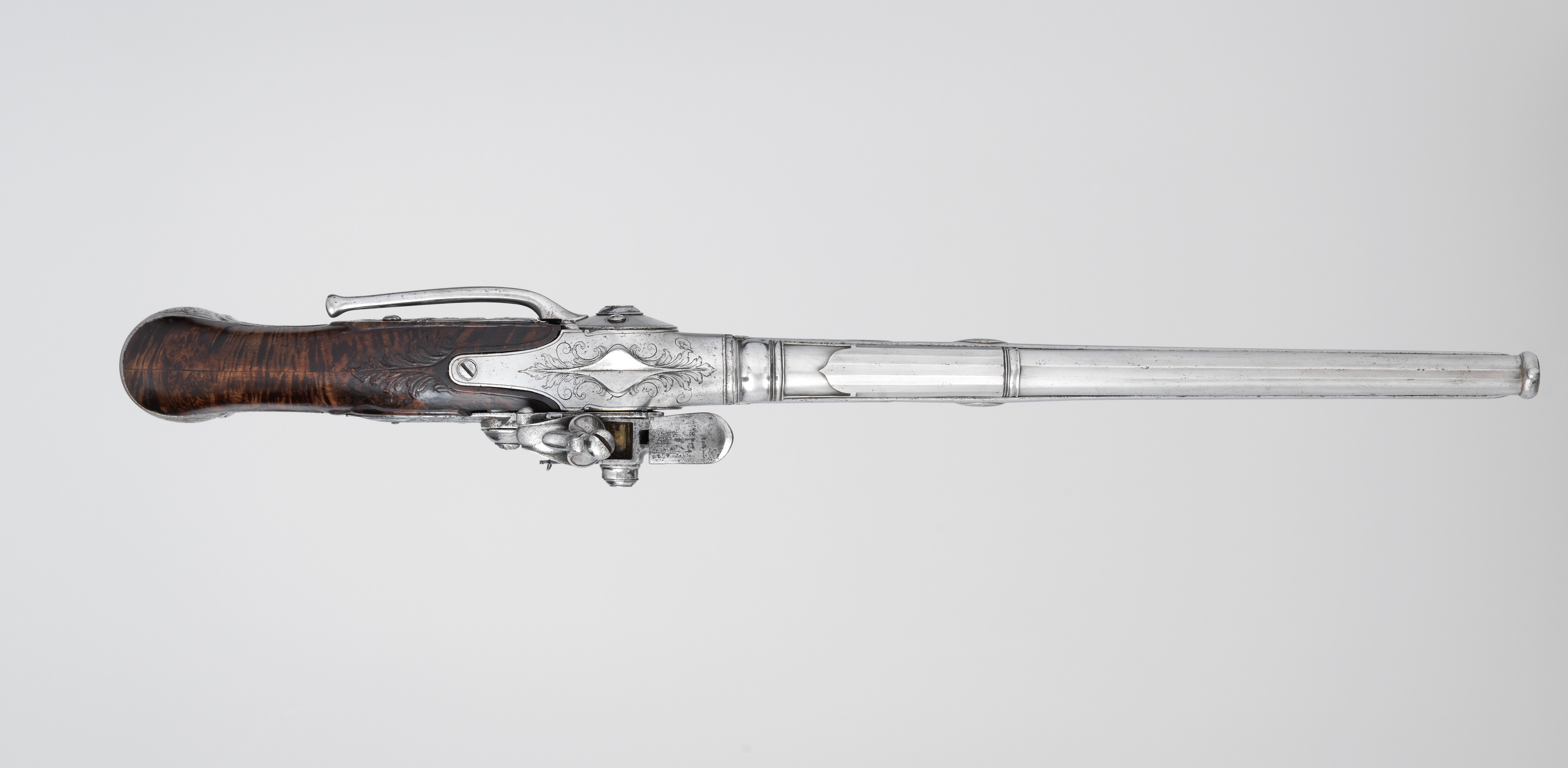Repeating Flintlock Pistol
Gunsmith Michele Lorenzoni Italian
Not on view
This pistol is a rare, early example of the Lorenzoni system, a popular breech-loading repeating mechanism developed for flintlock guns in the third quarter of the seventeenth century. In addition to its quality, fine decoration, and early date, the pistol is significant for being one of the few surviving examples signed by the eponymous Florentine gunmaker Michele Lorenzoni, the probable inventor of the system that bears his name.
Originally from Siena, Lorenzoni appears to have spent his entire career in Florence where he enjoyed the employ of the Medici court, competing with the gunmaker Matteo Cecchi, called Acquafresca (1651–1738), for favor. The earliest reference to Lorenzoni’s work is the mention of a repeating gun purchased from him in 1684 by Elector Johann Georg III of Saxony (1647–1691).
The Museum’s pistol is signed "Lorenzoni" on the right side of the action housing ahead of the drum, and "Firenze" on the brass breech block. It has figured walnut buttstock, a steel fore-end contoured as if made of wood with a dummy steel ramrod tube and ramrod beneath it, a four-stage barrel, and engraved steel mounts. Cosmopolitan in their decorative approach, Lorenzoni’s guns, like his rival Acquafresca’s, often show clear signs of French influence, with decorations derived from Parisian pattern books and formal characteristics inspired by contemporary French firearms. The engraved decorations on this pistol relate to designs published by Claude Simonin (1635–1693), and Adrien Reynier the Younger (ca. 1680–1743) and Charles Reynier (ca. 1700–1752) (both called Le Hollandois), among others, particularly the symmetrical, spiraled tendrils, acanthus leaves, and dot motifs framing the rear sight and following the molded contours of the fore-end. The serpent-headed tendrils, exotic birds, and grotesque masks adorning the lock and butt also recall French patterns.
The Lorenzoni system represented a significant improvement upon a related repeating mechanism designed by the Danish gunmaker Peter Kalthoff (d. 1672) and employed by gunmakers in northern Europe in the third quarter of the seventeenth century. Complex internally, the Lorenzoni system allows for up to ten successive shots that feed from discrete powder and ball magazines concealed inside the grip. To load the weapon, the pistol is held muzzle down and the steel handle on the left side turned approximately one-hundred-eighty degrees to allow powder and ball to fall into two chambers in the vertically-set, cylindrical brass breech block. The handle is then turned in the reverse direction to its original position, bringing the ball and powder in line with the barrel and forming a temporary breech, simultaneously opening a valve in the lock to release priming powder into the pan, cover the pan, and thrust back the cock.
The most reliable technology for creating a practical multi-shot firearm before the perfection of revolver mechanisms in the mid-nineteenth century, the Lorenzoni system was utilized by gunmakers throughout continental Europe and Great Britain for more than a century after its invention. It enjoyed a final revival in Great Britain in the late eighteenth century, becoming a specialty of London gunmakers Henry Nock (1741–1804) and Harvey Walklate Mortimer (1753–1819). The Metropolitan’s collection includes two Lorenzoni pistols by Mortimer, one a rare cased complete example bearing the crests of Vice Admiral Horatio Nelson (1758–1805) (acc. nos. 35.81.3a–f; 19.53.33).
Though the mechanism today bears Lorenzoni’s name and he is traditionally credited with its invention, whether he conceived the original design is a matter that has been debated by scholars for decades. The invention has been alternatively ascribed to the Italian gunmaker Giacomo Berselli of Bologna and subsequently Rome, among others. Lorenzoni made both long guns and pistols equipped with the mechanism in three variant sub-types, each differing in the location of the powder magazine and in the installation of additional fail-safe systems. Notably, few Lorenzoni-type pistols, as opposed to long guns, were made before the mid-eighteenth century, adding to this pistol’s rarity.
This pistol, the first Italian seventeenth-century Lorenzoni-type firearm to enter the Museum’s collection, was given to The Met in 2018 by the Robert M. Lee Foundation. It enables the Museum to represent this seminal early repeating firearm for the first time and to explain its far-reaching importance in the history of European firearm design and engineering. In addition it anchors and provides critical context for The Met’s later British examples of the mechanism.
Due to rights restrictions, this image cannot be enlarged, viewed at full screen, or downloaded.
This artwork is meant to be viewed from right to left. Scroll left to view more.




